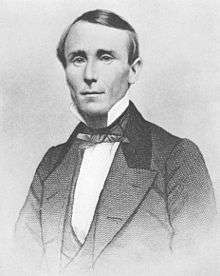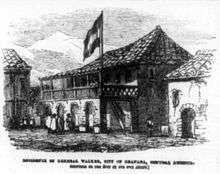Walker affair
In the Walker affair an American named William Walker briefly invaded Nicaragua in 1855 with a small army. He seized control of the country by 1856, but was ousted the following year.
| Date | 1855–1857 |
|---|---|
| Location | Republic of Nicaragua, Central America |
| Participants | William Walker's Filibuster Army, León and Granada Nicauraguan nationalists, Costa Rican, Honduran, and other Central American allies |
| Outcome | William Walker and his filibuster army of Americans were defeated and ousted from rule over Nicaragua by an allied alliance of Nicaragua, Costa Rica, Honduras, and other Central American countries which temporarily halted U.S. intervention and control of the region. |
| Deaths | 1,000+ |

.svg.png)
Background
Nicaragua’s independence from Spain, Mexico, and then from the United Provinces of Central America in 1838[1] did not free it from foreign interference.
The 1850s California Gold Rush created interest in the United States in finding a quicker route between the American east and west coasts. However, Great Britain had long been present on the coast of Nicaragua, which created tension between the two countries. The Clayton–Bulwer Treaty was signed in 1850, in which both sides "agreed that neither would claim exclusive power over a future canal in Central America nor gain exclusive control over any part of the region." Many Nicaraguans originally welcomed this treaty because of the potential financial benefits a canal could bring.
After Nicaraguan independence came a continuous conflict over power between the Nicaraguan cities of León and Granada, and their political parties (León housed the liberals and Granada the conservatives).
Walker's invasion
The liberal elite of León was losing the struggle to unseat the conservative elite of Granada and turned for help to a San Francisco-based soldier of fortune named William Walker. Walker was known as an adventurer who sought to take control of Latin American countries with the purpose of making them a part of the United States.[2]
Walker sailed in June 1855 from California to Nicaragua with a small band of armed Californians. After some initial military setbacks, he and his liberal allies took Granada in October and set up a coalition government.


By 1856, Walker declared himself president, re-instituted slavery, and made English the official language. U.S. President Franklin Pierce recognized his Nicaraguan government.
A movement arose to expel Walker and his army. This proved to be a long and costly process. Costa Rica, Honduras, and other Central American countries united to drive Walker out in 1857.[4] During this time, Granada was burned and thousands of Central Americans lost their lives. The final battle of what Nicaraguans called the "National War" (1856–57) took place in the spring of 1857 in the town of Rivas, near the Costa Rican border. Walker beat off the attacks, but the effort diminished the strength and morale of his forces and he soon succumbed.
The National War made for the cooperation between the Liberal and Conservative parties, which had brought Walker to Nicaragua.
References
- Minster, Christopher. "The Federal Republic of Central America (1823–1840)". Latin American History. About.com. Retrieved 2013-11-05.
- Lipski, John M. (1982), "Filibustero: Origin and Development", Journal of Hispanic Philology, VI (3): 213–238
- Dueñas Van Severen 2006, p. 140.
- Walker, W (1860). The War in Nicaragua. New York: S.H. Goetzel & Company.
Juda, F (1919). "California Filibusters: A History of their Expeditions into Hispanic America (excerpt)". The Grizzly Bear. XXI (4): 3–6, 15, 19. Retrieved 2011-07-20.
Baker, CP (2001). "The William Walker Saga". Moon Handbooks: Costa Rica (4th ed.). New York: Avalon Travel Publishing. p. 67. ISBN 978-1-56691-608-0.